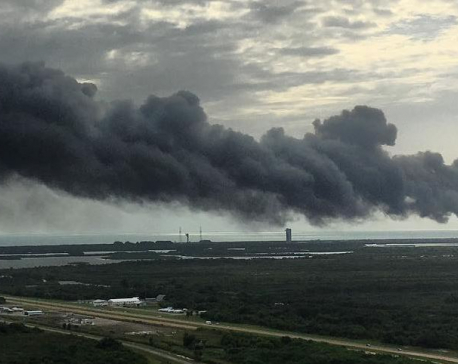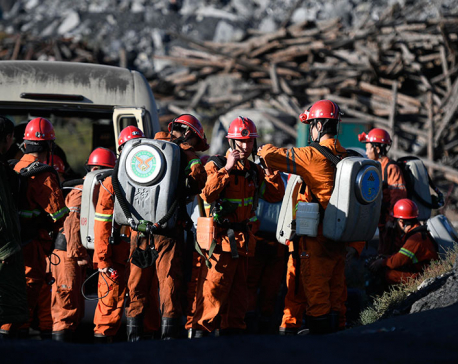
OR
Elon Musk's Starship explodes minutes after first test flight's liftoff
Published On: April 21, 2023 11:30 AM NPT By: Reuters

BOCA CHICA, Texas, April 20: SpaceX's next-generation Starship spacecraft exploded minutes after liftoff in an uncrewed test flight from South Texas on Thursday, cutting short a key step in Elon Musk's development of a rocket vessel to eventually take humans to the moon and Mars.
The flight test was the first for Starship mounted atop the company's new Super Heavy rocket, and the first launch ever for that lower-stage booster, which SpaceX has touted as the most powerful launch vehicle on Earth.
Even though the two-stage rocket ship made it less than halfway to the edge of space, climbing to just under 25 miles (40 km), the flight achieved a primary objective of getting the new vehicle off the ground at liftoff despite some of its engines failing.
While SpaceX officials were heartened by the outcome, the mission fell short of reaching several objectives.
The plan was for Starship to soar into space at least 90 some miles (150 km) above Earth before it would re-enter the atmosphere and plunge into the Pacific near Hawaii.
Even though the two-stage rocket ship made it less than halfway to the edge of space, climbing to just under 25 miles (40 km), the flight achieved a primary objective of getting the new vehicle off the ground at liftoff despite some of its engines failing.
While SpaceX officials were heartened by the outcome, the mission fell short of reaching several objectives.
The plan was for Starship to soar into space at least 90 some miles (150 km) above Earth before it would re-enter the atmosphere and plunge into the Pacific near Hawaii.
NASA chief Bill Nelson congratulated SpaceX on Twitter, saying, "every great achievement throughout history has demanded some level of calculated risk, because with great risk comes great reward."
NASA chief Bill Nelson congratulated SpaceX on Twitter, saying, "every great achievement throughout history has demanded some level of calculated risk, because with great risk comes great reward."
The spacecraft reached a peak altitude of about 24 miles (39 km) before its fiery disintegration, SpaceX said. The company also noted that the rocket reached the critical launch point of maximum aerodynamic pressure before appearing to lose control.
SpaceX officials on the webcast hailed the liftoff as a welcome accomplishment.
A throng of SpaceX workers shown during the webcast watching a livestream together at the company's headquarters near Los Angeles cheered wildly as the rocket cleared the launch tower - and again when it blew up.
'LEARNED A LOT'
Musk, shown seated in the Starbase mission control room in Boca Chica, Texas, wearing a headset, said on Twitter afterwards that the next Starship test launch would be in a few months.
"Congrats @SpaceX team on an exciting test launch of Starship! Learned a lot for next test launch," he tweeted. Musk, who purchased Twitter last year for $44 billion, is also CEO of electric carmaker Tesla Inc.
SpaceX principal integration engineer John Insprucker, one of the webcast commentators, said the experience would provide a wealth of data to inform further flight tests.
The road to Thursday's accident has not been without previous tests and setbacks.
A stationary test firing of the Super Heavy while bolted to a platform managed to ignite just 31 Raptor engines in February, and an earlier static firing test in July 2022 ended with the vehicle's engine section exploding.
Before that, SpaceX had test-launched prototypes of Starship's top half in five short flights to an altitude of 6 miles (9.7 km), seeking to perfect its return landing capability. All but one crashed in flames.
The spectacular nature of Thursday's loss of the first fully integrated Starship-and-booster vehicle during its introductory launch further highlighted challenges SpaceX faces moving beyond its workhorse Falcon 9 rocket, the centerpiece of the company's satellite launch business.
Still even a textbook test flight would have by design ended with crash landings of both portions of the spacecraft at sea.
The Super Heavy and Starship were each designed as reusable components, capable of flying back to Earth for soft landings in a maneuver that has become routine in dozens of missions for SpaceX Falcon 9 rockets.
For Thursday's launch, however, the flight plan called for the lower stage to fall into the Gulf of Mexico after separating from the upper stage, which would have come down in the Pacific Ocean near Hawaii after achieving nearly one full Earth orbit.
You May Like This

Explosion rocks SpaceX launch site in Florida during test
CAPE CANAVERAL, Fla., Sept 1: An explosion rocked a SpaceX launch site Thursday during a routine rocket test. ... Read More...

Six injured in Lahan bomb explosion
SIRAHA, Mar 23: Six people were injured in a bomb blast at the Bikas Traders, gold shop, Lahan, today. ... Read More...

7 coal miners dead in China after gas explosion
BEIJING, Oct 15: A gas explosion inside a coal mine in southwestern China has killed seven people and injured two more. Read More...

Just In
- World Malaria Day: Foreign returnees more susceptible to the vector-borne disease
- MoEST seeks EC’s help in identifying teachers linked to political parties
- 70 community and national forests affected by fire in Parbat till Wednesday
- NEPSE loses 3.24 points, while daily turnover inclines to Rs 2.36 billion
- Pak Embassy awards scholarships to 180 Nepali students
- President Paudel approves mobilization of army personnel for by-elections security
- Bhajang and Ilam by-elections: 69 polling stations classified as ‘highly sensitive’
- Karnali CM Kandel secures vote of confidence


















Leave A Comment